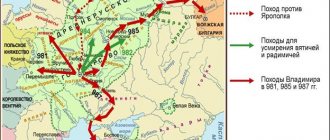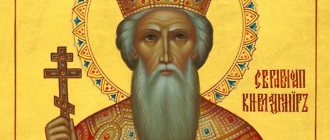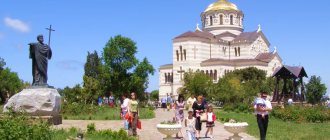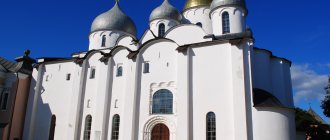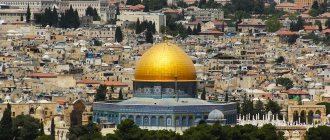The question of where Prince Vladimir was baptized remains controversial today. There are at least three versions of this. Supporters of the first name the place of baptism in Kyiv, the second - the town of Vasilyev, located not far from the first, and the third - Chersonesos. There is also no clear opinion about what year this event occurred. Today we propose to consider the opinion of a scientist, a supporter of one of the most popular versions regarding where Prince Vladimir was baptized.
Why not in Kyiv?
From 1972 to 1984 The Chersonesos expedition took place, organized by the USSR Academy of Sciences. It was headed by archaeologist and historian Sergei Alekseevich Belyaev. It was he who was the author of the scientific discovery associated with the discovery of the font in which Prince Vladimir was baptized. Regarding the opinion that this great event took place in Kyiv, on the banks of the Dnieper, the scientist says the following.
What happened in Kyiv in 988, in August, was already a consequence of the adoption of the Christian faith by Vladimir, which took place a little earlier and in a different place. According to Belyaev, Prince Vladimir was baptized in the city of Chersonese, and this could not have happened anywhere else. This, in particular, is evidenced by The Tale of Bygone Years. It talks about baptism in Korsun - that’s what Chersonesos was called by the Slavs.
Already in the 4th century, during the reign of Emperor Constantine the Great, this Byzantine city was the main Christian center of all Eastern Europe.
On the screen
To the cinema
- Ilya Muromets (1956; USSR) directed by Alexander Ptushko, in the role of Vladimir Andrey Abrikosov.
- Ruslan and Lyudmila (1972; USSR) directed by Alexander Ptushko, in the role of Vladimir Andrey Abrikosov.
In cartoons
- Vasilisa Mikulishna (1975; USSR) directed by Roman Davydov, Vladimir was voiced by Vladimir Basov.
- Alyosha Popovich and Tugarin the Zmey (2004; Russia) directed by Konstantin Bronzit, Vladimir was voiced by Sergei Makovetsky.
- Prince Vladimir (2006; Russia) directed by Yuri Kulakov, Vladimir was voiced by Sergei Bezrukov.
- Dobrynya Nikitich and Zmey Gorynych (2006; Russia) directed by Ilya Maksimov, Vladimir was voiced by Sergei Makovetsky.
- Ilya Muromets and Nightingale the Robber (2007; Russia) directed by Vladimir Toropchin, Vladimir was voiced by Sergei Makovetsky.
- Three Heroes and the Shamakhan Queen (2010; Russia) directed by Sergei Glezin, Vladimir was voiced by Sergei Makovetsky.
- Three heroes on distant shores (2012; Russia) directed by Konstantin Feoktistov, Vladimir was voiced by Sergei Makovetsky.
- Three heroes. The Knight's Move (2015; Russia) directed by Konstantin Feoktistov, Vladimir was voiced by Sergei Makovetsky.
Why not somewhere else?
According to Belyaev, this could not have happened anywhere else for the following reasons. The prince's plans were to marry Anna, a Byzantine princess. Before that, he had two legal wives and about 300 concubines. Making a Byzantine princess your wife was a very honorable thing. Judge for yourself. This was denied to the German Emperor Otto himself. And Prince Vladimir succeeded! And the princess was brought from Constantinople to Vladimir in Chersonesus.
For several centuries, Byzantium attracted barbarian tribes into the fold of the Christian Church. In addition, she sought to maintain peace on her own borders. Therefore, Vladimir was a completely suitable party.
But neither the Byzantine emperor nor the patriarch could allow a woman of such high rank to go outside the empire just like that. That is, without being married in a legal Christian marriage according to all church canons. It follows that the question of where to baptize Prince Vladimir and where to get married could only be decided unambiguously - only on the territory of Byzantium, of which Chersonesus was a part.
Vladimir Svyatoslavich, third son of Grand Duke Svyatoslav Igorevich and Malusha, daughter of the prince or governor Malk Lyubechanin, housekeeper of Vladimir’s grandmother, Grand Duchess Olga. It is traditionally believed that he received his baptismal name in honor of Saint Basil the Great, Archbishop of Caesarea (died 1 January 379) and in honor of his absentee godfather, the Byzantine Emperor Basil II the Bulgarian Slayer (died 15 December 1025). In order of succession to the throne, he is the fifth Grand Duke. Born in the village. Budutina weighed in the early 60s. X century (some historians, based on a unique message «
The chronicler of Pereyaslavl of Suzdal
"
(3rd quarter of the 15th century),
"died 73 years old"
dates his birth to an earlier time - 942) First mentioned in the chronicle in 969. In the spring of this year, when the Pechenegs besieged Kiev, is in the city together with his brothers in the presence of his grandmother, Grand Duchess Olga. On July 11 of the same year, she mourns her death with her father and brothers.
In the autumn of the same year, before finally leaving Kyiv, his father distributed the reign to his children. At the same time, ambassadors from Veliky Novgorod came to Kyiv and, on the advice of Dobrynya, Vladimir’s uncle, asked him to reign. With his father's consent, Vladimir and Dobrynya go to Veliky Novgorod.
In 977, Vladimir's brother, Yaropolk (who became the sovereign prince of Kyiv after the death of his father in the spring of 972) kills his other brother, Prince Oleg Drevlyansky. Having learned about this, Vladimir “ran overseas”
to the Varangians, and Yaropolk installed his mayors in Veliky Novgorod.
In 978 (according to the chronicle, in 980), Vladimir returned to Veliky Novgorod with the Varangian army and expelled the mayors of Yaropolk from the city, instructing them to inform his brother to prepare for battle. Then Vladimir sends matchmakers to Rogneda, the daughter of the Polotsk prince Rogvolod. The chronicler conveys the girl’s contemptuous response: “I don’t want to rouse.”
(taking off the groom’s shoes, as a sign of submission, goes back to ancient German law. -
D.V. Donskoy
)
robichich
(a hint of Vladimir’s origins from a slave mother. -
D.V. Donskoy
),
but I want Yaropolk.”
The offended Vladimir, together with Dobrynya, marches with an army to Polotsk, captures the city and kills Rogvolod and his two sons, and takes Rogneda herself by force as his wife.
After this, Vladimir goes to Kyiv. Stopping between Dorogozhych and Kapichy (tracts near Kiev; now within the city), he begins the siege of the city and wins over the governor Yaropolk Blud to his side. He agrees to kill his prince, but cannot do this due to the mood of the people of Kiev. Then Blud persuades Yaropolk to leave the city. June 11, 978 Vladimir enters Kyiv, abandoned by his brother, and takes the princely throne. Yaropolk flees to the south and secludes himself in the city of Rodna.
Here Vladimir again besieges his brother. Experiencing terrible hunger and again succumbing to the entreaties of Blud, Yaropolk surrenders to his brother and leaves the city to negotiate with him. Vladimir receives his brother in his father’s castle courtyard. When Yaropolk passes through the door, two Varangians kill him. At the same time, Vladimir took as his wife the widow of Yaropolk, a beautiful Greek woman who, in the words of the chronicler, was “not idle”
(pregnant -
D.V. Donskoy
); Soon she will give birth to a son, Svyatopolk, adopted by Vladimir.
In the same year, Vladimir released the Varangian squad to Byzantium and thereby saved himself from the need to pay them a ransom for the capture of Kyiv; he keeps to himself only the “kind and meaningful”
husbands to whom he distributes to keep the city. He puts his uncle Dobrynya in Veliky Novgorod.
According to the chronicle, having become the prince of Kiev, Vladimir placed idols (statues) of pagan gods on a hill near the tower palace: “Peruna is made of wood, and his head is silver, and his mustache is gold, and Khurs, Dazhbog, and Stribog, and Simargla, and Mokosh.”
; arranges pagan sacrifices near them.
In 981, Vladimir went to war against the Lyakhs (Poles) and occupied the so-called “Cherven” cities: Przemysl, Cherven and others. In the same year he defeats the Vyatichi and imposes “tribute from the plow”
the same as they paid his father Svyatoslav. The next year, Vladimir makes another campaign against the Vyatichi and defeats them again.
At the beginning of 983 he goes against the Yatvingians and conquers their land. Upon his return from this campaign, a human sacrifice is performed in Kyiv “on Perunov Hill” on July 12: the Varangian Fedor and his son Ivan, who later became Orthodox first-martyrs, are sacrificed. In the next 984, Vladimir sends his commander named Wolf Tail to the Radimichi, who defeats them on the river. Pishchane (right tributary of the Sozh River).
In 985, together with his uncle Dobrynya, Vladimir goes to the Bulgars (apparently the Volga, contrary to the opinion of V.N. Tatishchev, who considered the goal of the campaign to be a war with the Bulgarians and Serbs) and concludes an “eternal” peace with them ( “either not The world will be between us, as soon as a stone begins to float, and hops begin to sink.”
), after which he returns to Kyiv. Apparently, Vladimir’s war with the Khazars dates back to the same time. In addition, in the first years of his reign, Vladimir had to fight with the Pechenegs, to whom the governor of Yaropolk, Varyazhko, fled after the death of his prince.
Under 986–987 The chronicle contains a story about the “test of faith” by Prince Vladimir: missionary envoys from the Volga Bulgar-Mohammedans, Khazar Jews, Western Christians and Orthodox Greeks come to him, inviting him to accept his faith. In turn, Vladimir gathers the boyars and city elders (that is, the two branches of princely power) and, with their advice, sends ten “kind and sensible”
husbands to test and choose their faith. Upon the return of the ambassadors, the boyars and elders, together with the prince, decide to accept the Christian faith from the Greeks.
According to the Russian chronicle and Byzantine sources, Vladimir’s baptism occurs as follows. In 988, the prince went with an army to the Greek city of Korsun (Chersonese Tauride, an ancient city in the Crimea, founded by immigrants from Pontic Heraclea in the 5th century BC; now the city of Sevastopol), and after a long siege and as a result of the betrayal of a certain Korsunian Anastas takes possession of it in late summer - early autumn. This is confirmed by the testimony of a Byzantine chronicler of the 10th century. Leo Deacon (died after 992), who associates the subsequent appearance of Halley's comet with this event.
From Korsun, Vladimir sends to the Byzantine emperors, brother-co-rulers (from the Macedonian dynasty) Vasily II the Bulgarian Slayer and Constantine VIII (died November 11, 1028), demanding the hand of their younger sister Anna; in case of refusal, he threatens to capture Constantinople (Constantinople) itself. The emperors agree to this, despite the fact that their grandfather, Emperor Constantine VII Porphyrogenitus (of the Macedonian dynasty; died November 9, 959), instructed their father Emperor Roman II (died March 15, 963) not to agree to the requirements for concluding such marriage unions: “If ever the people of any of these unfaithful and wicked northern tribes (that is, not Christian. - D.V. Donskoy
) will ask for kinship through marriage with the basileus of the Romans, that is, either to receive his daughter as a wife, or to give your daughter away, either to the basileus as a wife or to the son of the basileus, you must reject this unreasonable request of theirs.” In addition, they refuse the hand of their sister to the German Emperor Otto III (from the Saxon dynasty; died January 21, 1002), for whom Anna was already betrothed.
They base their consent to this marriage on the fact that the Russian prince supported them during the civil war (987–988), sending a military corps, and also gave them assurances to accept baptism.
Princess Anna arrives in Korsun, accompanied by Greek dignitaries and priests, and preparations for the wedding begin. However, Vladimir suddenly gets sick with his eyes. Anna gives him advice to be baptized immediately ( “if you want to get rid of this disease, then be baptized soon”
), and Vladimir accepts it:
“if there is truth, then God will be truly great.”
Metropolitan Theophylact (?) and the Bishop of Korsun, who arrived with Anna, baptize Vladimir, and he is immediately healed of his illness.
Following the prince, his squad also receives baptism. After baptism, Vladimir “brings the queen to the wedding”
and arranges a feast.
After which Vladimir goes to Kiev, taking with him not only Anna, but also the Korsun priests, the relics (should be understood as the head) of the Holy Pope Clement I (killed in 101) and his disciple Thebes, church utensils and icons kept in Korsun “for your blessing”,
as well as two copper
“temples”
(idols -
D.V. Donskoy
) and a copper quadriga of horses.
However, historians also allow a different interpretation of the events associated with the prince’s baptism, and in particular, they consider it possible that Vladimir was baptized in Kyiv even before the campaign against Korsun. It must be borne in mind that, according to eastern sources, the marriage of Vladimir and Anna was preceded by negotiations between the Russian prince and the Byzantine emperors regarding the possibility of providing military assistance to the Empire in connection with the war with Bulgaria and the rebellion of the nephew, the deceased Byzantine emperor Nicephorus II, commander Vardas (from Phocas ; killed April 13, 989). According to the Syrian Christian chronicler Yahya of Antioch (died about 1066), “Russian troops arrived there and united with the Greek troops that were with Tsar Basil.” According to some reports, the strength of this military corps reached 6,000 soldiers. On Saturday, April 13, 989, near the city of Avidos (Abydos), the Russian army played a decisive role in the victory of Emperor Basil and the defeat of the rebel Varda.
In 989 Vladimir returned to Kyiv. At his command, the pagan idols that he himself installed several years ago are overthrown. Following this, Vladimir baptizes his sons and sends an announcement throughout the city, demanding that all people gather the next day for baptism: “If anyone is not found... let him be disgusted with me.”
. On the appointed day, in the presence of Vladimir himself, the Korsun and “Tsarina” priests baptize the people of Kiev in the river. Dnieper (according to another version, in the Pochayna River, the right tributary of the Dnieper; now does not exist).
Then Vladimir orders to build churches in cities and villages and baptize people, and “deliberately children”
(notable people. -
D.V. Donskoy
) take children and send them
“for book training
. The historian V.N. Tatishchev (died July 15, 1750), a story has been preserved from the Joachim Chronicle (XVII century), which has not reached us, that his uncle Dobrynya and the Novgorod thousand-man Putyata suppress the anti-Christian rebellion in Veliky Novgorod and forcibly baptize the Novgorodians: “Putyata baptize with a sword, and Dobrynya is fire.”
According to the chronicle, upon baptism, Vladimir distributes the cities among his eldest sons and gives Vysheslav - Veliky Novgorod, Izyaslav - Polotsk, Svyatopolk - Turov and Yaroslav - Rostov. (Later, after the death of Vysheslav, Yaroslav was transferred to Veliky Novgorod, Boris received Rostov, Gleb - Murom, Svyatoslav - Drevlyansky land, Vsevolod - Vladimir-Volynsky, and Mstislav - Tmutorokan.)
The chronicle dates the beginning of Vladimir’s endless wars with the Pechenegs to the same time. By order of the prince, the construction of fortresses begins along pp. Desna (left tributary of the Dnieper), Ostra (left tributary of the Desna), Trubezh (left tributary of the Dnieper), Sule (left tributary of the Dnieper) and Stugne (right tributary of the Dnieper); “And while the men were picking up the best from the Slovens and from the Krivichs and from the Chudi and from the Vyatichi and from these, they inhabited the cities, fighting from the Pechenegs.”
The largest of these fortresses is the city of Belgorod on the river. Irpen (right tributary of the Dnieper) - Vladimir puts it in 991.
In 989, Vladimir invited craftsmen from Byzantium and instructed them to build the Church of the Blessed Virgin Mary. This church receives the name Tithe Church, since the Grand Duke establishes that a tenth of all income should be given to it. In the spring of 996, the construction of the church was completed, and after its consecration (May 12), Vladimir entrusted it to Metropolitan Leonty (died in 1008 (?)) and Presbyter Anastas Korsunyanin; issues him a special letter for church income.
In 992 Vladimir goes “against the Croats”
(meaning one of the Polish tribes. -
D.V. Donskoy
).
In the same year on the river. Trubezh (the left tributary of the Dnieper) it reflects the invasion of the Pechenegs. According to legend, the outcome of the war is decided by the single combat of a certain Kozhemyaki youth with a Pecheneg hero. In honor of the victory, Vladimir places the city of Pereyaslavl in that place ( "before the glory of the youth"
), and makes the youth himself and his father great men.
In 996, Vladimir was defeated by the Pechenegs near the city of Vasilyev and almost was captured “on the day of the Transfiguration of the Lord”
(permanent celebration of August 6. -
D.V. Donskoy
). Then, according to his vow, he built a church in Vasilevo and organized an eight-day feast, after which he returned to Kyiv. In general, the chronicle and “The Life of Prince Vladimir” (11th century) note his amazing love of poverty and mercy: the prince constantly gives out huge alms - and not only in money, but also in food, drink and clothing.
Having become a Christian, the chronicler writes, the prince tries to live in peace with neighboring countries and devoutly observes the gospel commandments. So, fearing sin, the prince even refuses to execute the robbers and only at the insistence of the bishops agrees to this.
According to later chronicles, in 991 Vladimir received the Pecheneg prince Kuchyug in Kyiv, who converted to Christianity there. At the same time he received the ambassadors of Pope John XV (died in March 996) and, in turn, sent ambassadors to Rome (returned in 994). In 994 and 997 makes successful campaigns against the Volga Bulgars.
The chronicle covers the second half of Vladimir's reign in much less detail. It is only known that in 1000 his wife Rogneda (in monasticism Anastasia) and a certain Malfred died. In 1001 his son Izyaslav died, and in 1003 his grandson Vseslav Izyaslavich died. In 1007, unnamed saints (presumably the relics of Princess Olga) were transferred to the Church of the Most Holy Theotokos (Tithe).
In 1007 or 1008 (exact dating is difficult), Vladimir received in Kyiv a German missionary, Bishop Bruno of Querfurt (killed on March 9, 1009), and through his mediation made peace with the Pechenegs. In his letter to the German king Henry II (of the Saxon dynasty; died July 13, 1024), the bishop calls Vladimir “the ruler of the Rus, powerful thanks to his kingdom and wealth,” and mentions that he sent them as hostage of one of his sons (according to academician V.T. Pashuto (died in 1983), Svyatopolk).
In 1011, his wife Princess Anna dies, who, according to the Arab chronicler Yahya of Antioch, built “many churches in the country of the Rus.” Vladimir buries her in the Tithe Church.
In 1013, Vladimir fought with the Polish prince Boleslav I the Brave (of the Piasts; died July 17, 1025), who attracted the Pechenegs to his side as allies.
In 1014, Prince Yaroslav of Novgorod raised a rebellion against his father: he refused to transfer the usual tribute to Kyiv, 2000 hryvnia per year. Vladimir intends to go on a campaign against Yaroslav and calls his son Boris to Kyiv, but falls ill. At this time, another invasion of Rus' by the Pechenegs took place. Vladimir sends Boris against them, but he is no longer destined to wait for his return.
Vladimir “ruled the aforementioned kingdom for a long time, died as a very old man” on July 15, 1015 in the village of Berestovo near Kiev. His body, wrapped in a carpet and, in accordance with custom, placed on a sleigh, is transported to Kyiv and, according to the recollection of the German chronicler of the Merseburg bishop Thietmar (died December 1, 1018), buried in the Tithe Church, in a marble sarcophagus, “next to with his named wife; their tombs stand in a prominent place in the middle of the temple.”
The coffin and relics of the prince were lost at the end of 1240 under the ruins of the church after the capture of Kyiv by the Tatar-Mongols. Four centuries later, around 1635, after the Uniates returned the cathedral to the Orthodox at the behest of the Kyiv Metropolitan Peter Mohyla (died December 31, 1646), while dismantling the ruins of the temple, the remains of Prince Vladimir Svyatoslavich were discovered. At the same time, the prince’s head was placed in a ark in the Assumption Cathedral of the Kiev-Pechersk Monastery (currently lost), and the right hand was placed in the St. Sophia Cathedral (Kyiv; currently lost). At the end of 1640, “the lower bone with teeth”
(lower jaw -
D.V. Donskoy
) was given by Metropolitan Peter Mogila as a gift to Tsar Mikhail Fedorovich (from the Romanovs, died July 13, 1645) to the Cathedral of the Assumption of the Virgin Mary (in the Kremlin; known from the inventory of 1701 and currently lost ). The remains of parts of the prince's sarcophagus, according to the memoirs of nun Nektaria Borisovna Dolgorukaya (died in 1771), were last seen in the mid-60s. XVIII century under the Kiev Metropolitan Arseny Mogilyansky (died June 8, 1770).
The Russian Orthodox Church canonized the blessed Prince Vladimir as a saint and equal to the apostles.
Being a pagan for half his life, Vladimir had many wives, of which five are known, who bore him sons:
1) “Czech woman” (later non-chronicle sources call her Varangian princess Olava), mother of Vysheslav;
2) Rogneda (also named Gorislava by Vladimir; in monasticism Anastasia), mother of Izyaslav, Yaroslav, Mstislav, Vsevolod, as well as two daughters, including one known from the chronicle of Predslava;
3) “Greek woman”, widow of Prince Yaropolk, mother of Svyatopolk, adopted by Vladimir;
4) “another Czech woman,” the mother of Svyatoslav (or perhaps Stanislav?) (later non-chronicle sources call the mother of Svyatoslav and Stanislav a certain Czech princess Adil or Malfrid. The latter is considered by some historians to be a Scandinavian);
5) “Bulgarian”, mother of Boris and Gleb (according to the Tver Chronicle and some later sources, their mother was the Byzantine princess Anna).
Vladimir also had sons Sudislav, Pozvizd and Boleslav, but the chronicle does not say who their mother was, and according to non-chronicle data, it was a concubine. According to foreign sources, it is also known about the existence of at least eleven daughters of Vladimir (later sources name the names of some of them: Mstislav, Pryamislav).
In addition to the "led"
(legal -
D.V. Donskoy
) wives, Vladimir had many concubines in Vyshgorod, Belgorod and Berestov.
“And I am unsatisfied with fornication,
” the chronicler writes about him, “
bringing to me men’s wives and depraved girls;
“He’s a woman lover, like Soloman” (Jew, King Solomon; died in 928 BC
-
D.V.
Donskoy
).
After baptism, Vladimir renounces his harem and marries twice according to Christian rites:
6) in 989 on Anna, the twenty-six-year-old daughter of the Byzantine emperor Roman II and his second wife Theophano (died after 976). From her, according to some sources, Vladimir had a daughter, Dobronega-Maria, and, presumably, another daughter, Feofania, the wife of the Novgorod mayor Ostromir (baptized Joseph; killed after May 1057 (?));
7) after Anna’s death (in 1011), Vladimir marries again, but it is not known exactly who. According to non-chronicle data, Vladimir also had a son, Vyacheslav, who died in 1024.
How did Vladimir make the decision?
By the time of his marriage to Princess Anna, Vladimir was already ready for baptism. According to the chronicle, back in 986 he raised the question of which faith to choose. He received ambassadors from Volga Bulgaria who offered to convert to Islam, Khazar Jews who invited him to Judaism, and missionaries from the Vatican. But they were all refused. After them, a Byzantine arrived who spoke about the Christian faith.
To find out how rituals were carried out and what laws each religion had, the prince sent ambassadors to worship the Germans, Greeks and Muslims. Ultimately he chose Christianity.
Consolidation of power
In order to give legitimacy to his rule, Vladimir Svyatoslavovich decided to enlist the support of the priests. He liked paganism because it justified polygamy and did not condemn him for having a huge number of concubines.
To appease the idols, the prince built a temple in his capital. Rituals and sacrifices were regularly held there. Vladimir Svyatoslavich ordered the main idol Perun to be given the features of himself.
The people were impressed by the prince's worship of traditional gods, so they treated the new ruler well. In addition, the first 10 years of the reign of Vladimir Svyatoslavich were marked by numerous victories over warlike neighbors, especially in the west, which helped strengthen the borders and allowed the population not to fear raids.
What did the font look like?
Understanding the question of where Prince Vladimir was baptized, it will be interesting to find out how this happened. It is assumed that initially the font in which the sacrament was performed was exactly as it was depicted by the artist Vasnetsov in the painting in the Vladimir Cathedral in Kyiv.
In Chersonesos it was carved into the rock; at the moment its depth is 74 centimeters. When it was opened in the 80s of the 19th century, it was discovered that the entire recess was lined with marble. The cross located at the bottom was also lined with marble. Unfortunately, over time, all this splendor was stolen, and today there is a bare rock with a light brown color. The cross has also not survived.
At that time, the baptismal chapel was perceived as an ordinary temple. In the 90s of the 19th century, the assumption that the marble font carved into the rock was exactly the place where Prince Vladimir was baptized was expressed by Alexander Lvovich Bartier, an outstanding Russian engineer. During the Soviet years, Belyaev's expedition explored the monument in its entirety. And from historical, and from archaeological, and from canonical, and from liturgical points of view.
It is now considered proven that it was on the site of the former temple (baptismal chapel), in the found font, that the baptism of Vladimir in Chersonesos took place. After S. A. Belyaev toured all of Europe with a report on this topic, the scientific community accepted this evidence.
Family
The father of Prince Vladimir was the famous commander and at that time the ruler of Kyiv Svyatoslav Igorevich. The latter was the only son of Igor Rurikovich and Princess Olga, who was the first among Russian rulers to convert to Christianity.
Vladimir's mother, Malusha, was the housekeeper and alms distributor for Princess Olga. She yielded to the claims of Svyatoslav, who was married to the Ugric princess Predslava and had two sons from her - Yaropolk and Oleg.
Olga, angry at Malusha, who conceived a son in sin, sent her to the village of Budyatino. When the boy was 3-4 years old, he, already without his mother, was returned to Kyiv. There he was under the supervision of his grandmother Olga, since pagan laws accepted him as a princely heir. In addition, Vladimir was looked after by his maternal uncle Dobrynya, who was the Kyiv governor.
How did the gazebo come about?
Previously, through the baptismal chapel, which was not fenced, there was a path to the beach, and people came here. As you know, during the years of perestroika, the authorities’ attitude towards the church changed, and the revival of temples and churches began. The then dean of the local district, Father Georgy Polyakov, had the idea of installing a gazebo here in order to somehow immortalize the place where Prince Vladimir was baptized. When it was made and had to be installed, support was not found from the museum management. This was in the late 90s of the last century.
Then Father George found an original way out. The specialists with whom he agreed delivered the gazebo to the font by helicopter. It was lowered as accurately as possible, and then attached to the rock in the most reliable way. This is how the place where Prince Vladimir was baptized was marked.
In search of a new unifying ideology
The pantheon of gods among the various tribes inhabiting Vladimir's domain was quite diverse, so paganism prevented the formation of a powerful unitary state. Being a far-sighted politician, the prince understood that the country needed a more advanced religion. Then Christianity attracted his attention, especially since its adherents were increasing every day, including among nobles. Suffice it to say that Vladimir Svyatoslavich’s own grandmother professed this religion. During his childhood years spent at the court of Princess Olga, he probably had the opportunity to observe how Kyiv Christians carried out their rituals. In addition, the prince most likely could have had some idea about the salvation of the soul and resurrection after the Day of Judgment.
The political aspect of choosing Christianity as the state religion was also important for Vladimir, which promised the strengthening of allied relations with Byzantium.
Where did the wedding take place?
It is assumed that after baptism in the font, Vladimir walked along the path to the temple of the Apostle Peter. It should be noted that its steps have been preserved to this day. There he became a participant in the liturgy and was married to Anna Porphyrogenitus. Although the baptismal chapel is a separate building, it is still part of the ensemble of the Church of the Apostle Peter. It was excavated in 1853, and it was built under Constantine the Great in the 4th century.
Today, the Cathedral of St. Vladimir in Chersonesus was built near this place. The author of his project is David Grimm, academician of architecture. The style of this building is neo-Byzantine. Construction was carried out using donations over a period of 30 years, from 1861 to 1892. This cathedral is the second largest on the Crimean peninsula, its height is 26 meters.
Feuds between brothers
When the sons grew up, Svyatoslav, who had previously been more interested in military campaigns than in affairs in the lands under his control, distributed them to his sons. As a result, Yaropolk received Kyiv, Oleg received the land of the Drevlyans, and Vladimir Svyatoslavich was sent as governor to Novgorod.
After the death of his father in 972 in a battle with the Pechenegs, his heirs became full rulers in their principalities. However, peaceful life soon came to an end.
For a minor reason, Oleg killed Yaropolk's comrade-in-arms. He flew into a rage and, at the instigation of the Varangian governor Sveneld - the father of the stabbed warrior - decided to take away the Drevlyan lands from his brother. A battle took place in which Oleg was crushed to death by his own retreating warriors. Having become the ruler of not only Kyiv, but also the Drevlyan lands, Yaropolk decided to remove Vladimir from the road, especially since he always considered him the son of a slave and placed him below himself.
Did Prince Vladimir build the temple?
According to S.A. Belyaev, he excavated a church located not far from the temple of the Apostle Peter. This is next to a section of the defensive wall, in the place where Vladimir stood with the settlement. This object was a dilapidated Byzantine church, recreated by the prince immediately after baptism and before leaving Korsun.
The restoration was carried out by the Grand Duke in memory of the great sacrament. Thus, for the first time in Rus', he introduced the custom of commemorating significant events in the history of the state and in human life in this way. In conclusion, it is worth noting that 988 is the year of the baptism of Prince Vladimir, which is considered the official date. But besides this, as it turned out, there are a number of other versions. However, this is a topic for a completely different article...
Power grab
To achieve the final victory over his brother, Vladimir Svyatoslavich resorted to bribery. He managed to win over to his side the governor Blud Iveshchey, who persuaded Prince Yaropolk to leave Kyiv and strengthen himself in the Roden fortress. Soon Vladimir's army arrived there and began a siege. The defenders of the fortress had a hard time. Yaropolk was forced to agree to negotiations. However, his brother prepared a trap for him and killed him in an ambush. In Rodin, Vladimir took a liking to his brother’s pregnant wife, a former Greek nun. Soon after this, the woman gave birth to a son, Svyatopolk, whom the prince raised as his own.
Historical evidence about how and when the baptism of Vladimir Svyatoslavich took place
Oddly enough, no reliable contemporary records of this important event have been discovered. In this regard, the testimony of the Armenian chronicler Stepanos (Stephan) Taronsky is especially valuable. He lived at the same time as the prince and was creating the “Universal History” precisely during the period when Vladimir was choosing a new religion for his state.
In his work, Stepanos described the events that took place from 885 to 1004. Remembering the events that took place in the year 1000, he writes about the 6,000 foot army of the Ruzes, which was in Armenia. According to him, these were soldiers who arrived at the request of Emperor Vasily. According to Stepanos, this happened when the latter gave his sister in marriage to Vladimir. We also read there that this event coincided with the fact that the Ruz believed in Christ.
As for other sources, they confirm Stepanos’s testimony, but provide more detailed information.
In particular, many chroniclers indicate that Vladimir decided to marry the sister of the Byzantine emperors, Anna. They agreed, demanding military assistance in the fight against the rebel Varda Foka. The princess herself opposed the brothers' decision, but later agreed to become the wife of the Russian prince if he converted to Christianity. The most reliable information about this event is reported by the Syrian historian of the 11th century, Yahya of Antioch.


